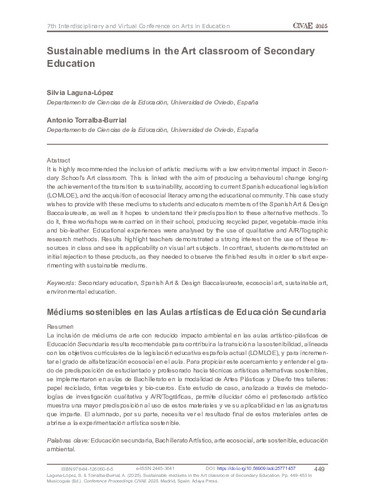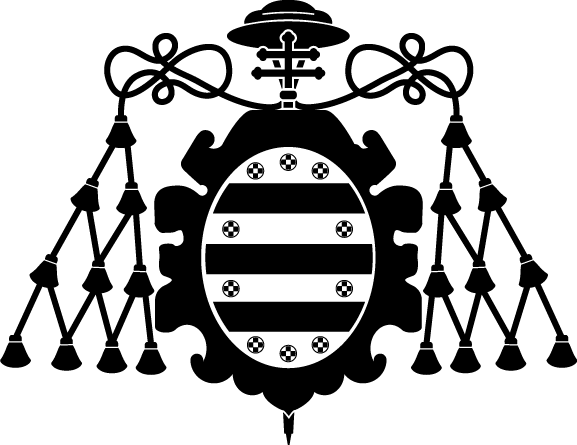Sustainable mediums in the Art classroom of Secondary Education
Otros títulos:
Médiums sostenibles en las Aulas artísticas de Educación Secundaria
Autor(es) y otros:
Palabra(s) clave:
Educación artística
Educación ambiental
Educación para la sostenibilidad
Educación Secundaria
Ecosocial art
Arte ecosocial
Arts education
Environmental education
Education for Sustainability
Secondary education
Fecha de publicación:
Editorial:
Adaya Press
Versión del editor:
Citación:
Descripción física:
Resumen:
It is highly recommended the inclusion of artistic mediums with a low environmental impact in Secondary School’s Art classroom. This is linked with the aim of producing a behavioural change longing the achievement of the transition to sustainability, according to current Spanish educational legislation (LOMLOE), and the acquisition of ecosocial literacy among the educational community. This case study wishes to provide with these mediums to students and educators members of the Spanish Art & Design Baccalaureate, as well as it hopes to understand their predisposition to these alternative methods. To do it, three workshops were carried on in their school, producing recycled paper, vegetable-made inks and bio-leather. Educational experiences were analysed by the use of qualitative and A/R/Tographic research methods. Results highlight teachers demonstrated a strong interest on the use of these resources in class and see its applicability on visual art subjects. In contrast, students demonstrated an initial rejection to these products, as they needed to observe the finished results in order to start experimenting with sustainable mediums. ------------------------------------------------------------------------------------------------- La inclusión de médiums de arte con reducido impacto ambiental en las aulas artístico-plásticas de Educación Secundaria resulta recomendable para contribuir a la transición a la sostenibilidad, alineada con los objetivos curriculares de la legislación educativa española actual (LOMLOE), y para incrementar el grado de alfabetización ecosocial en el aula. Para propiciar este acercamiento y entender el grado de predisposición de estudiantado y profesorado hacia técnicas artísticas alternativas sostenibles, se implementaron en aulas de Bachillerato en la modalidad de Artes Plásticas y Diseño tres talleres: papel reciclado, tintas vegetales y bio-cueros. Este estudio de caso, analizado a través de metodologías de investigación cualitativa y A/R/Tográficas, permite dilucidar cómo el profesorado artístico muestra una mayor predisposición al uso de estos materiales y ve su aplicabilidad en las asignaturas que imparte. El alumnado, por su parte, necesita ver el resultado final de estos materiales antes de abrirse a la experimentación artística sostenible.
It is highly recommended the inclusion of artistic mediums with a low environmental impact in Secondary School’s Art classroom. This is linked with the aim of producing a behavioural change longing the achievement of the transition to sustainability, according to current Spanish educational legislation (LOMLOE), and the acquisition of ecosocial literacy among the educational community. This case study wishes to provide with these mediums to students and educators members of the Spanish Art & Design Baccalaureate, as well as it hopes to understand their predisposition to these alternative methods. To do it, three workshops were carried on in their school, producing recycled paper, vegetable-made inks and bio-leather. Educational experiences were analysed by the use of qualitative and A/R/Tographic research methods. Results highlight teachers demonstrated a strong interest on the use of these resources in class and see its applicability on visual art subjects. In contrast, students demonstrated an initial rejection to these products, as they needed to observe the finished results in order to start experimenting with sustainable mediums. ------------------------------------------------------------------------------------------------- La inclusión de médiums de arte con reducido impacto ambiental en las aulas artístico-plásticas de Educación Secundaria resulta recomendable para contribuir a la transición a la sostenibilidad, alineada con los objetivos curriculares de la legislación educativa española actual (LOMLOE), y para incrementar el grado de alfabetización ecosocial en el aula. Para propiciar este acercamiento y entender el grado de predisposición de estudiantado y profesorado hacia técnicas artísticas alternativas sostenibles, se implementaron en aulas de Bachillerato en la modalidad de Artes Plásticas y Diseño tres talleres: papel reciclado, tintas vegetales y bio-cueros. Este estudio de caso, analizado a través de metodologías de investigación cualitativa y A/R/Tográficas, permite dilucidar cómo el profesorado artístico muestra una mayor predisposición al uso de estos materiales y ve su aplicabilidad en las asignaturas que imparte. El alumnado, por su parte, necesita ver el resultado final de estos materiales antes de abrirse a la experimentación artística sostenible.
Descripción:
Conference Interdisciplinary and Virtual Conference on Arts in Education, CIVAE (7th. 2025. Virtual)
ISBN:
ISSN:
Colecciones
- Ciencias de la Educación [1072]
- Ponencias, Discursos y Conferencias [4233]
Ficheros en el ítem





